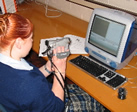Secondary 7
Five Year 10 pupils took the question ‘How can ICT make a place of worship come alive in RE?’ as their starting point to produce a virtual tour of a local Roman Catholic church. The pupils were from Tudor Grange High School in Solihull and were part of an IT extension class. They met with the Head of RE twice a week (one after school meeting and one lunchtime meeting) for the duration of the project.
The pupils' first step was to evaluate other web-based virtual tours. These did not have to be places of worship, and included:
St James the Great Church, Shirley:a tour developed by the curate of a local parish church when working with Year 4 pupils in the local church primary school.
St Alban's School: a tour of the school using JPEGs.
Explore the Taj Mahal: a 360 degree panoramic view of the Taj Mahal in India.
From this the pupils developed a list of criteria which the new virtual tour needed to meet. These included:
making the language accessible to the target audience (in this case, pupils in Years 6 and 7)
using movie and audio clips to help bring the church 'alive'
having prompt questions for pupils to encourage thinking about what is shown
building intuitive navigation into the site
liaising with key personnel in the place of worship (in this case, the parish priest)
creating a sense of movement so that the website really conveyed the sense of being in and walking around the place of worship
using school-based resources so that the project could be replicated in other schools
allowing for comparison - for example, including pictures of lecterns from other denominational churches.
The pupils made several trips to the church, Our Lady of the Wayside, to take digital pictures and recordings, including a 360 degree panoramic view.
The group then edited the images in school. After many discussions, the pupils devised the website structure and developed the site.
Planning
Planning the website took a lot of time, and the pupils had to consider many issues - for example, how the individual pages should look and what they should include. They sat down together and worked out different ideas on paper. One of their main concerns was the way into the site and how they could create a sense of movement into and around the church. They also considered how they could make the site visually engaging and easy to navigate.
Issues
A lot of the discussions revolved around what to include on the website. There were many debates about the type of background and the amount of information on each page.
The issues were often resolved by the class thinking about and talking through the needs of Year 6 pupils: what could they understand? What did the pupils want the younger children to learn from the site?
Liaison with primary schools
The group showed the primary school pupils the front pages that had been developed and asked them to evaluate the existing material. In an organic process, the Year 10 pupils responded to constructive criticism by making changes to the pages. The younger pupils also made recorded statements about the features of their church. These were then included on the site.
The project group used digital video (DV) to record a Corpus Christi service involving Our Lady of the Wayside school pupils. The group then incorporated parts of that movie into the website.
As a result of this project the pupils:
increased their knowledge of the objects found in a church, and gained a greater understanding of their
symbolic and liturgical significance.
increased their understanding of the diversity found within Christianity.
learned how to become religious educators themselves, asking questions any RE teacher would about what pupils should gain from a virtual tour.
developed their personal and social skills through increased confidence in presenting their work to different audiences.
learned new skills in using web authoringsoftware, digital cameras and editing equipment.
How ICT enhanced teaching and learning
As developing the virtual tour was an 'out of school hours' project it is not suitable as a formal assessment against RE criteria. However, through self-evaluation, the pupils have:
gained a respect for the building and the people that bring it alive
shown responsibility in representing the church with sensitivity and authenticity
increased their understanding of the place and meaning of worship in the Roman Catholic Christian tradition
reflected on the diversity of styles of worship and buildings within the Christian faith
shown empathy with younger children involved in the church
analysed the way in which objects are used and applied that information to the web pages
increased awareness of the church as a focal point of the community.
Links and resources
For a more detailed outline of this digital video project, see the Teacher Resource Exchange, Developing a virtual tour in RE.

